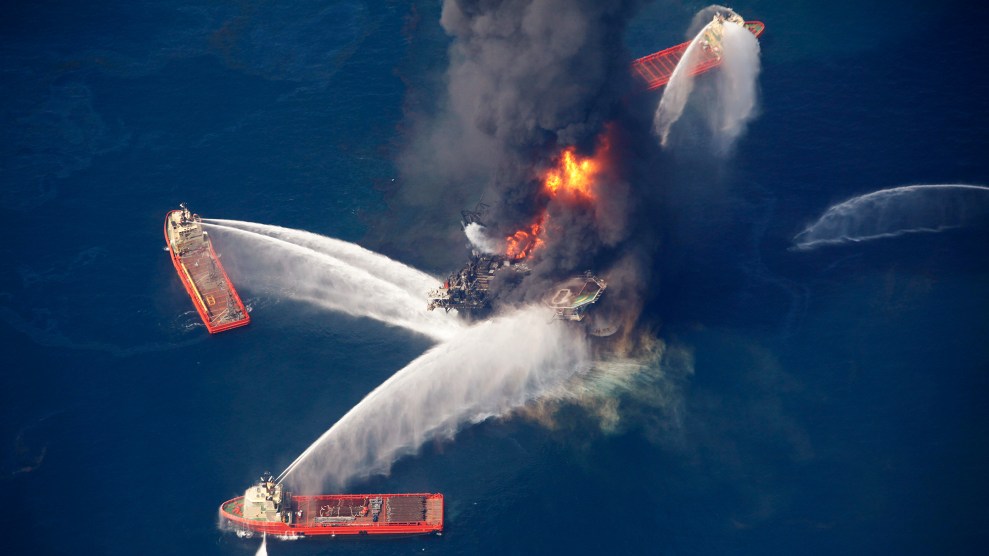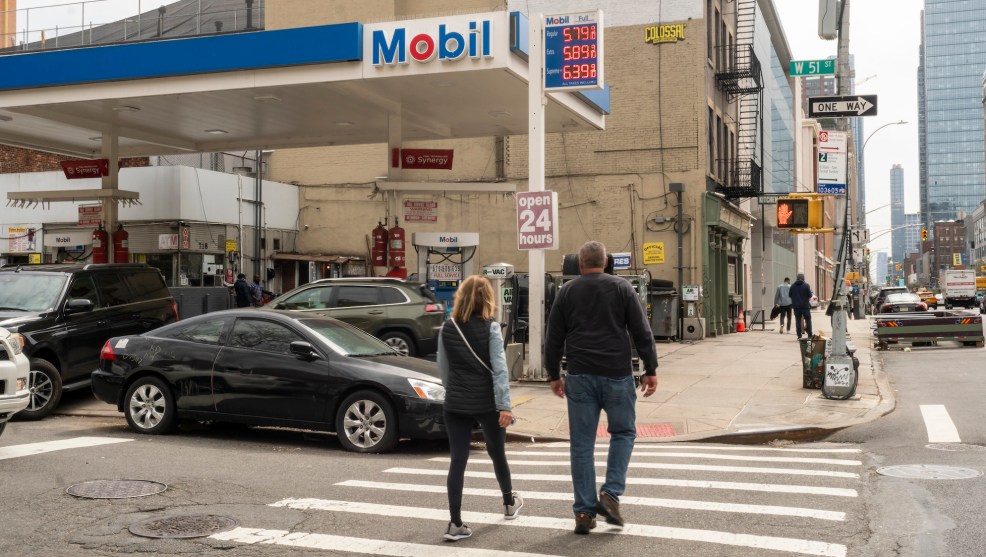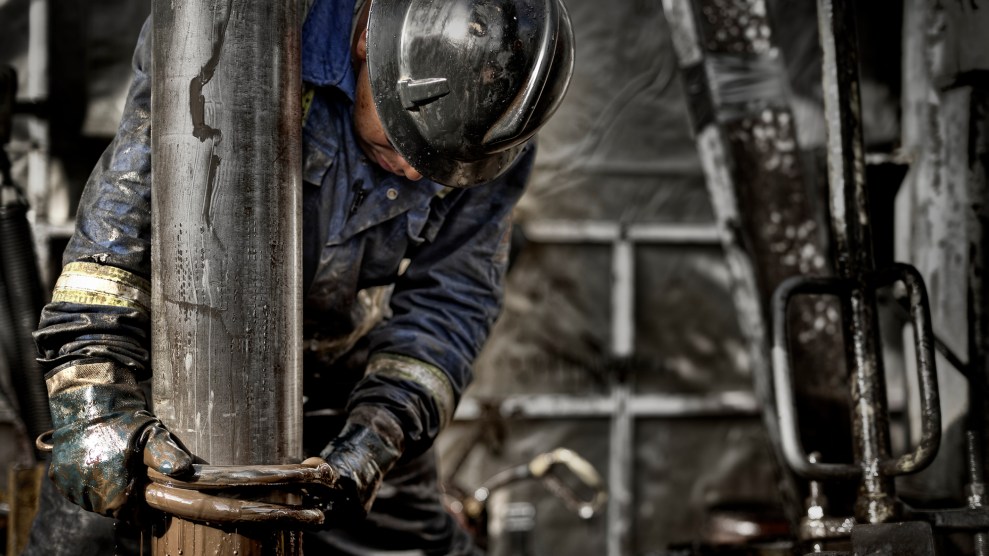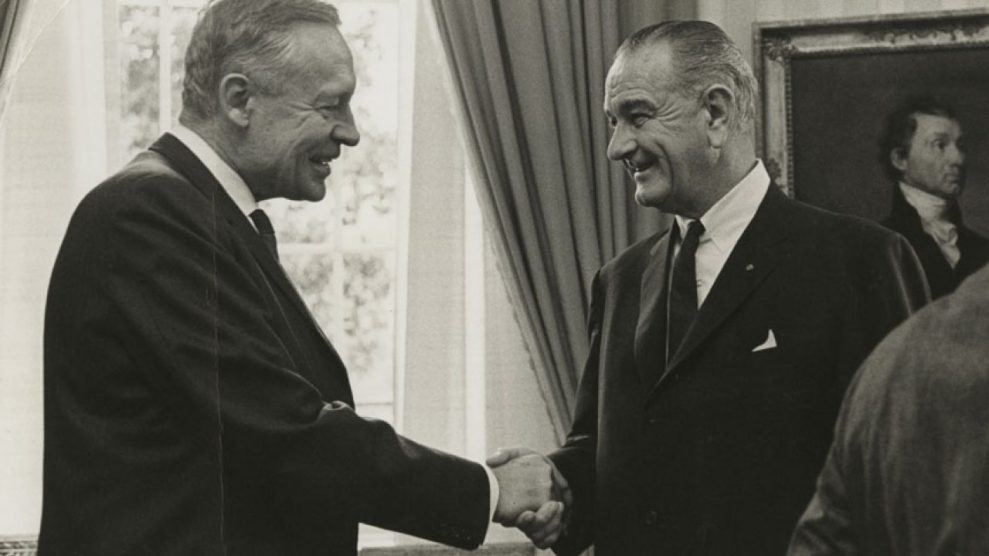
Scientist Roger Revelle, an adviser who warned Lyndon Johnson about climate change in 1965, greets the president in the Oval Office.Roger Revelle papers/Special Collections Archives/UC San Diego
This story was originally published by Yale E360 and is reproduced here as part of the Climate Desk collaboration.
Carroll Muffett began wondering in 2008 when the world’s biggest oil companies had first understood the science of climate change and their product’s role in causing it. A lawyer then working as a consultant to environmental groups, he started researching the question at night and on weekends, ordering decades-old reports, books, and magazines off Amazon and eBay, or from academic libraries.
It became a years-long quest, and as he pressed on, Muffett noticed one report kept coming up in the footnotes of the memos and papers he was poring through—a 1968 paper commissioned by the American Petroleum Institute, the powerful fossil fuel trade group, and written by Elmer Robinson and Bob Robbins, scientists at the Stanford Research Institute, known as SRI. Muffett wasn’t sure what it said, but it was cited so often he knew there must be something big in it.
Then part of Stanford University, SRI wasn’t an ordinary department, but a contract research outfit that had been intertwined from its founding with oil and gas interests. The paper had been delivered privately to the petroleum institute, not published like typical academic work, and only a few copies had spilled into the public realm. Long since forgotten, they had been gathering dust in a handful of university libraries. Eventually, through an interlibrary loan, Muffett managed to get a hold of one. “There seems to be no doubt that the potential damage to our environment could be severe,” the authors wrote in the 1968 paper.
“Once I actually opened it, it was immediately clear how profoundly important it was,” he remembers. “It was absolutely a jaw drop moment.” This was the earliest, most detailed and most direct evidence Muffett had yet seen that the industry’s own experts had warned its largest trade organization, not just an individual company, “that the science around climate change was clear, it was abundant, and that the best indications were that the risks were really substantial.” The paper’s delivery date put it well before Exxon’s extensive 1970s research into climate risks.
In stark terms, the decades-old paper explained that the world’s use of fossil fuels was releasing carbon that had been buried for millennia, and “it is likely that noticeable increases in temperature could occur,” if that burning continued. That would mean warming oceans, melting ice caps, and sea levels that could rise by as much as four feet per decade, the report predicted. “There seems to be no doubt that the potential damage to our environment could be severe,” the authors concluded. “The prospect for the future must be of serious concern.”
The Center for International Environmental Law, an advocacy group Muffett now runs, published excerpts in 2016. Now, the paper—along with a follow-up that Robinson and Robbins produced in 1969—is playing a key role in a wave of lawsuits seeking to hold oil companies accountable for climate change.
Minnesota, Delaware, Rhode Island, Baltimore, and Honolulu are among about two dozen US states and localities suing the industry. Some of the cases seek compensation for the damage wrought by climate-driven disasters like floods, fires, and heat waves, plus the cost of preparing for future impacts. Others allege violations of state or local laws prohibiting fraud and other deceitful business practices, or requiring companies to warn consumers of a product’s potential dangers. The defendants, which vary from case to case, include the American Petroleum Institute as well as major companies such as ExxonMobil, Shell, Chevron, BP, and ConocoPhillips.
The suits’ common thread is the charge that the industry has long understood emissions from oil and gas combustion would drive warming—and create a host of major global risks—but carried out a decades-long misinformation campaign to confuse the public and prevent a shift to cleaner fuels. Most cite Robinson and Robbins’ work. The pair’s reports have been proffered internationally too, most notably in a Dutch case in which a court last year ordered Shell to slash its carbon emissions by 45 percent by 2030; the company is appealing. European courts have been more favorable for cases seeking to force such reductions or push governments to strengthen climate policies, while US suits generally aim at extracting financial penalties or compensation from companies.
Last month, New Jersey became the most recent state to sue. “As a result of the fossil fuel industry’s lies and deceit, the State has paid billions of dollars to clean up climate change-induced disasters like Superstorm Sandy; to fortify the Jersey Shore from future storms; and to protect its people, businesses, infrastructure, and natural resources from a myriad of other climate change hazards,” its complaint charged. “It is time to halt this deceptive conduct and place responsibility for remedying its effects on Defendants, where it belongs, rather than the taxpayers of New Jersey.”
The industry “can’t say they didn’t know when they commissioned the study,” a climate policy expert says of Robinson and Robbins’ research.
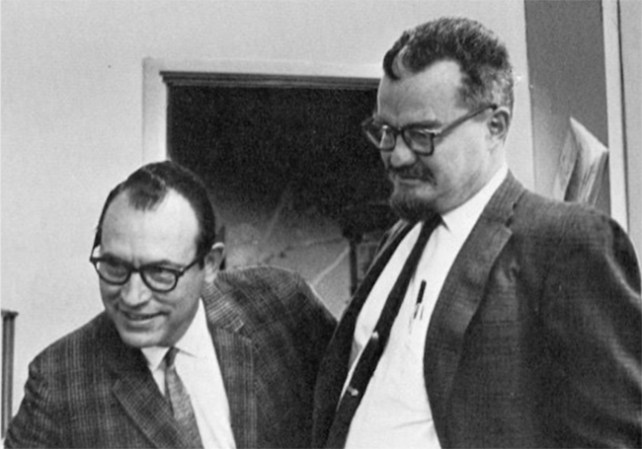
Bob Robbins (left) and Elmer Robinson.
Courtesy of the Center for International Environmental Law and SRI International
There’s plenty of evidence of fossil fuel companies’ early awareness of climate risks, some now even predating 1968—indeed, the science was already a matter of public discussion in the mid-1960s—and the Robinson and Robbins papers are just two of many documents the court filings marshal. Others include Inside Climate News’ and the Los Angeles Times’ 2015 reports on Exxon’s internal climate research and its use of that science to prepare its assets to withstand dangers such as rising seas and intensifying storms. Those investigations focused mainly on the 1970s and later—after the papers by Robinson and Robbins were written.
But those papers pack a unique punch that goes beyond just their early dates, said Richard Wiles, president of the Center for Climate Integrity, an advocacy group that works with localities considering climate litigation: The industry “can’t say they didn’t know when they commissioned the study.” That will be key if any of the pending cases reaches trial, said Patrick Parenteau, emeritus professor and senior climate policy fellow at Vermont Law School. “There’s going to be a ferocious fight over evidence, and the validity, the admissibility, of these various documents,” according to Parenteau, and the Robinson and Robbins’ papers’ direct link to industry makes it more likely a judge would admit them.
The involvement of the American Petroleum Institute—whose members include nearly all the biggest oil producers—also widens the scope of knowing culpability well beyond ExxonMobil, the company for which the most detailed evidence of early knowledge of climate science exists, said Wiles.
The petroleum institute declined an interview request. “The record of the past two decades demonstrates that the industry has achieved its goal of providing affordable, reliable American energy to US consumers while substantially reducing emissions and our environmental footprint,” it said in a statement. “Any suggestion to the contrary is false.”
While the idea of litigating over a problem as big as climate change may seem like a leap, “this is classic product liability law,” Parenteau said. “The law’s not novel at all. The law is plain vanilla. The consequences are huge. The stakes are enormous—that’s what makes [the cases] different.”
It was World War II that started Elmer Robinson on his career in meteorology. He had been a math major at UCLA, but the country needed navigators for bombing runs in the Pacific, and he looked like a promising candidate for the US armed forces. So he soon found himself studying the intricacies of weather patterns and the atmosphere. The atomic bombing of Japan ended the war just as he was preparing to ship out, but the training stuck. Within a few years, Robinson was a meteorology and atmospheric science specialist at the Stanford Research Institute.
Robinson and Robbins believed CO2 needed to be studied because it was “the only air pollutant which has proven to be of global importance.”
By the 1960s, he was heading SRI’s environmental research department, working from a run-down wooden building on the edge of campus. Despite the title, he was no green crusader. SRI provided studies for hire for companies and government agencies and would eventually spin off from the university to become an independent, nonprofit research group. “The prime responsibility of Stanford Research Institute is to serve industry,” a booklet touting its work declared.
A photograph from the late ‘60s shows Robinson, broad and husky, with a bushy goatee and tweedy jacket, standing beside Robbins, a slimmer colleague with slicked-back hair who had expertise in chemistry. The American Petroleum Institute hired the pair to examine what ultimately became of the pollution that the burning of fossil fuels created. Corporate clients often looked to the institute for help understanding their environmental impact—in part, says Donald Nielson, author of A Heritage of Innovation: SRI’s First Half Century, so they would be ready if they ever had to defend themselves in court.
The report Robinson and Robbins delivered—its ungainly title was “Sources, Abundance, and Fate of Gaseous Atmospheric Pollutants“—was thorough and detailed, 123 pages long. They surveyed six different pollutants, five of which were harmful mainly to those who breathed them, or to crops and other plant life. The sixth, carbon dioxide, posed a different problem, Robinson and Robbins explained. Many didn’t even think of it as a pollutant, they wrote, a perspective that was “perhaps fortunate for our present mode of living, centered as it is around carbon combustion.” But the men believed it belonged in their review because it was “the only air pollutant which has proven to be of global importance.”
It was ironic, they noted, that while much attention had focused on pollutants whose damage was local and discrete, almost no one seemed concerned about carbon dioxide’s potential to wreak havoc on a far wider scale. That dynamic had shaped efforts to reduce pollution, they noted, as better technology began cleaning up the country’s air. “What is lacking,” Robinson and Robbins wrote, was “work towards systems in which CO2 emissions would be brought under control.”
Their science wasn’t ground-breaking—what Robinson and Robbins provided was simply a clear-eyed distillation of an emerging consensus. In 1965, in a message to Congress, President Lyndon Johnson, whose scientific advisors warned him about climate change, had written that “this generation has altered the composition of the atmosphere on a global scale” in part because of “a steady increase in carbon dioxide from the burning of fossil fuels.”
Reading that presidential letter was what had prompted Carroll Muffett to begin the digging that led him to Robinson and Robbins’ reports. When the White House is raising concerns about your product’s impact on the planet, he remembers wondering, “what responsible CEO or corporate executive doesn’t know everything” about the issue in question?
So he started reading corporate histories, notes from conferences—anything that helped him understand how oil and gas companies worked and what they cared about. “This stuff was publicly available in the sense that it was not locked away in a vault,” he explains. But it was hard to find, tucked behind paywalls in corporate and scientific archives, or couched in obscure language that made searching difficult. “There was a lot of information hiding out there in plain sight.”
The 1969 paper cited models predicting atmospheric CO2 would reach 370 parts per million by 2000—astonishingly close the actual reading of 369.71.
When he finally got his hands on Robinson and Robbins’ first report, he understood the legal consequences immediately. While even earlier documentation has since emerged, at the time the SRI paper was the earliest—and most direct—evidence Muffett had seen that industry leaders were aware of the dangers continued fossil fuel use could pose. Within a few weeks of releasing details of the paper—Inside Climate News also reported his finding—Muffett recalls, “I had a lawyer calling me saying, ‘Can you send me a copy?’”
And there was more. Muffett had been seeing mentions of a supplement Robinson and Robbins wrote in 1969, a year after their main report. It was even harder to track down than the original paper, but through a chain of inter-library loans, his team at the Center for International Environmental Law, which had joined him in the search, eventually managed to get their hands on “like, the one copy of this thing that we could find in the United States.”
It seemed the American Petroleum Institute had asked for more, and this time, the scientists offered even greater detail. They cited models predicting atmospheric carbon dioxide would reach 370 parts per million by 2000—astonishingly close to the actual reading of 369.71 at millennium’s end. Such an increase, they said, would raise global temperatures by 0.5 degrees Celsius; that was on the money too. Polar ice cap melting caused by further warming, Robinson and Robbins wrote, “would obviously result in inundation of coastal areas.”
With the world now watching the dangers Robinson and Robbins anticipated play out, the US lawsuits citing their work face an uncertain legal path. Industry has been pushing to move them to federal court, where its lawyers argue the Clean Air Act is the only valid tool for regulating greenhouse gases.
“This global challenge does not lend itself to a patchwork of baseless lawsuits in state courts pursuant to state laws,” Chevron lawyer Theodore Boutrous said last month. Judges have so far ruled against the companies on that important procedural issue, repeatedly returning the suits to state courts, which are seen as more favorable to plaintiffs. Now the US Supreme Court is weighing companies’ request that it intervene to move the cases to federal court. The justices have asked the Justice Department for its view before deciding.
If the cases eventually get before state court juries, advocates for the litigation strategy contend they could extract massive damages—or big settlements—from industry, as happened in litigation over tobacco, opioids, and asbestos. Like the climate suits, those cases alleged “corporate deception leveled at the public for decades, resulting in a huge cost to all society,” said Ben Franta, senior climate litigation research fellow at Oxford University’s Smith School of Enterprise and the Environment, who has advised some climate plaintiffs. They “are good examples that the legal system can take on big societal harms that the other branches of government frankly are just not addressing.”
The lawsuits could accelerate a clean energy transition by scaring investment away from oil and gas. If fossil fuel companies are forced “to internalize even a fraction of the damage that they cause to society through global warming,” Franta said, “then that completely changes the commercial attractiveness of these companies as investments. Their litigation exposure could be enormous, ultimately.”
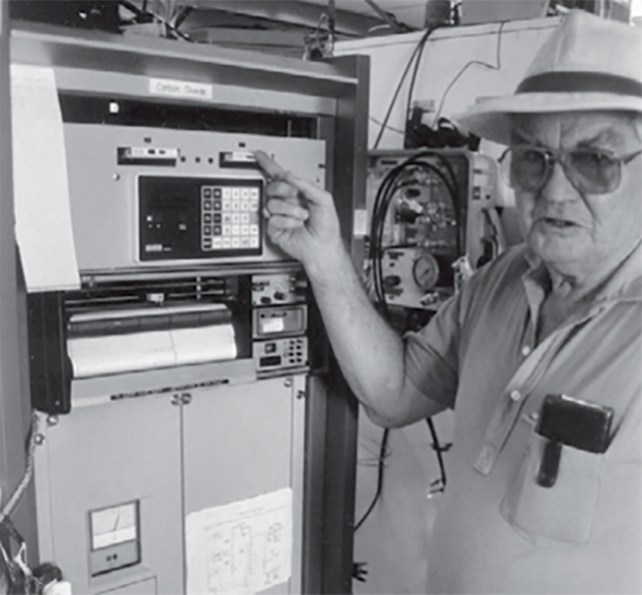
Robinson at NOAA’s Mauna Loa observatory in Hawaii.
Courtesy of Brian Lamb
The climate lawsuits are likely to drag on for years. “Who will be able to go the distance against the biggest companies in the world?”
And winning damages could make a big difference to municipalities struggling to find the resources to cope with climate-fueled disasters and prepare for worse, Wiles said. For many, it boils down to questions like “are we going to build a senior center, or are we going to build a sea wall,” he said. “It’s just a fairness issue. This is just ‘polluter pays.’”
But the cases are likely to drag on for years, and the fight is sure to be brutal. “It’s like a horse race at this point” among the many lawsuits, Parenteau said. “Who will be able to go the distance against the biggest companies in the world, who are now bigger and richer than they’ve ever been, and who have an open checkbook” for fighting suits that could cripple them financially—and don’t hesitate to hit back at those who sue them, he said. “The stars have really got to align for these plaintiffs to win a big ticket verdict.”
Perhaps because of his common name, efforts to find any of Bob Robbins’ relatives or colleagues to shed light on his career were unsuccessful. But as for Elmer Robinson, he eventually left the Stanford Research Institute and the apricot groves of northern California for eastern Washington’s snowy hills and a post at Washington State University. In 1985, he moved again, to become director of the National Oceanic and Atmospheric Administration’s Mauna Loa observatory in Hawaii, the high-altitude station whose measurements of atmospheric carbon dioxide are the most widely cited yardstick for tracking levels of the gas. He and Robbins had drawn on the station’s readings in both of their papers.
As director, Robinson—who died in 2016, at 91—worked mostly from an office in town, but now and then he would make the long, steep ascent to the observatory. Once, he brought a National Geographic reporter along, and they wound together through lava fields “sometimes jagged as cinders, sometimes smooth as swirled chocolate,” the journalist wrote. Up above the clouds, gazing at a mesmerizing view, Robinson told the writer that observatory records showed atmospheric carbon dioxide had risen 27 percent since the mid-1800s.
